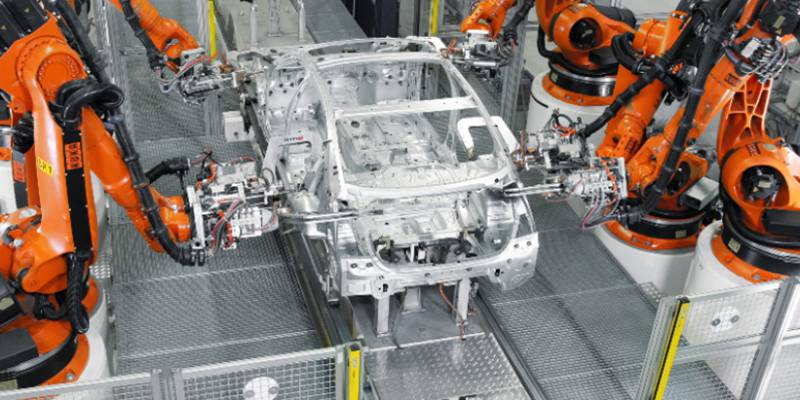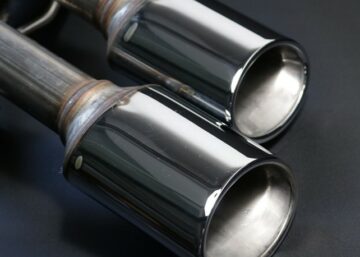Welding is an important process in the automobile industry. It is used to join together different metal parts of a car. Auto manufacturers use different welding techniques, depending on the type of metal and the desired outcome.
In this article, we will go through some common welding techniques used in the automotive industry, and throw some light on the welding applications and car components assembled through welding.
Welding Techniques Used in Automotive Industry
Welding is an excellent method for joining two metals permanently. Since the whole body and structural components of the car are metallic, welding is a viable solution for joining these components.
Welding is used in manufacturing as well as the repair of automobiles. In car manufacturing, resistance spot welding has the major share. However, other automotive welding techniques including TIG, MIG, and Laser Welding are also in practice.
Let’s get to know each of these techniques in more detail.
 Resistance Spot Welding
Resistance Spot Welding
Resistance spot welding is the oldest and most commonly used in the automobile industry. Some say that it has nearly been used in the auto sector for about 150 years. On average, an ordinary car has about 5,000 spot welds for joining different metal sheets and add-ons.
In spot welding techniques, two metal sheets are pressed between two copper electrodes. An electric current passes through the two contacts, which heats up and melts the metal, joining the two sheets together.
One advantage of spot welding is that it produces very clean and smooth welds. Another advantage is that it can easily be automated and the company can increase its production. Lastly, it is a low-cost, energy-efficient process. That is why it has gained popularity over the years in the auto industry.
MIG Welding
Like spot welding, MIG welding also has been a part of the auto industry for some time. It is considered a great technique for merging sheet metal. In fact, you will find MIG welders in most auto welding shops.
MIG stands for Metal Inert Gas Welding. This type of welding uses an electrode (Filler) which is fed through a wire. The wire melts and joins the two pieces of metal together. The filler material is usually carbon and stainless steel. However, you can also use Aluminium, copper, and magnesium alloys based on your needs. The shielding or inert gases are argon, helium, and carbon dioxide.
MIG welding is a common technique in the car welding industry for auto body welds and sheet metal parts.
 Tungsten Inert Gas Welding (TIG Welding)
Tungsten Inert Gas Welding (TIG Welding)
Unlike MIG, TIG is a type of welding that uses a non-consumable tungsten electrode to produce the weld. A gas shield, usually argon, is used to protect the weld from contamination. TIG welding is a more difficult welding process than spot welding, but it produces cleaner and stronger welds.
TIG welding is often used for auto body welds involving aluminum and stainless-steel parts. It is also used when welding thin metal sheets together, as it produces a strong and clean weld.
Laser Beam Welding
It is a type of welding that uses a laser to heat up and melt metal. Laser welds are very strong and have a very low level of contamination. In the car welding industry, manufacturers use it to weld together parts that are difficult to reach with other welding methods.
Laser welding is an excellent option for making connections in the electric motor and battery pack that are normally made of conductive materials.
Welding Applications in Automotive Production
Welding has extensive applications in the automotive industry. For instance, we use it to join together metal parts of a car, such as the body, chassis, car panels, and other suspension components.
Furthermore, welding has a major role to play in the repair and making of after-market car parts, such as exhaust systems and custom bumpers.
 Automotive Sheet Metal Parts
Automotive Sheet Metal Parts
Welding is commonly used to join together sheet metal parts in the automotive industry. These parts include brackets, hinges, spring seats, caps, covers, etc. Most of these parts are welded through TIG or MIG welding techniques.
Structural Body Components
Auto companies use welding to join together structural body components, such as the chassis and frame. These parts are usually made of thicker steel, and TIG welding is often used to weld them together.
In addition, welding is also used in the manufacturing seamless fewer fuel tanks, attachment of body panels, radiators, and bumpers. Most of these manufacturing involves resistance spot techniques. As mentioned earlier, a normal car has about 5000 spots welds at multiple locations.
Electric Vehicles (EVs)
The rising number of electric vehicles on the road is indicative of the current trend toward the electrification of motors. These cars need welding of their motor components such as powertrain connectors and stator pins. In addition, creating a battery cell, joining cells together to form a module or pack, and connecting modules together to form a full battery assembly; all involve welding. In electric vehicles, the common technology is laser welding.
Create and Repair
In addition use to the use of welding in auto manufacturing, welders use it to repair cracked or damaged parts, as well as to create custom parts. In terms of repair and maintenance, one will find four use cases of welding.
Frame or Fender: This is a common use case of welding. In auto shops, mechanics use welds to repair damage from a collision. It is also used to add strength and support where none previously existed. For example, if the frame of your car has been bent in an accident, then you may want to consider having it straightened out by having someone weld on new pieces.
Exhaust Applications: In some cases, welding is used to repair or replace an exhaust system. This is a common use case for welders because exhaust systems are often made of very thin metal that isn’t strong enough to withstand the stress of regular driving. Secondly, exhaust systems are prone to rust and corrode. If you have a leaky pipe that needs fixing, then you may want to consider having it welded on instead of replaced entirely.
Wheels Application: Wheels are another common application of welding. For example, if a wheel has been bent out of shape in an accident, then it may not fit on your car properly anymore. In that case, then you may consider having it straightened out by welding. As a result, you don’t need to replace the entire wheel, which saves your time and money in the long run.
After-Market Parts: Another welding application in the auto repair industry is the creation of after-market market parts such as external bumpers, fuel tanks, and radiators. Welders build these components by employing different Aluminium welding techniques.
Tips for Welding Automotive Sheet Metals
Are you are planning to restore your old vehicle? If so, keep these few tips in mind when welding the automotive sheet metal.
 Wear all Safety Equipment
Wear all Safety Equipment
Safety should be your priority. When welding auto parts wear all safety gear i.e. gloves, goggles, and the safety hood. Don’t skip any of these. Exposure to even a tiny metal splinter can ruin your eyes and skin.
Clean the welding Surface
It is important to work with a clean surface so that the welds will not be compromised. If dirt or grease gets on the metal during the welding process, then this can cause problems for your finished product. A good way to prevent this from happening is by using a brush to remove all dirt and grease before starting.
Use Low Power Setting
Since the metal sheets of the car are quite thin, it is a possibility that you end up creating a hole in the sheet if you set your welder on a high-power setting. That is why start welders with lower power settings.
Choose the Appropriate Filler Materials
Choose a filler metal that matches the mechanical characteristics of your specimen. The filler should be less thick than the metal sheet it is covering. For example, a filler of thickness of 0.6 mm is an ideal choice for welding a thin metal sheet of 1 mm.
Using the correct filler metal reduces the chance of corrosion, cracking, and other welding problems to occur.
Employ Skip Welding Technique
Unevenly distributed heat distorts and warps fitting components. To avoid warping, try to spread heat as uniformly as possible. An intermittent or stitch weld method, known as skip welding, can help to accomplish this.
The process of skip welding utilizes a sequence of stitch or short welds at important spots to secure the thin sheet metal. After letting it cool for a few minutes, the TIG welder can weld skipped spots.
Work with Small Diameter Wire
In MIG welding, utilize the lowest diameter solid wire electrodes available. The smaller the wire, the greater the welder’s control.
Similarly, smaller wires take require less energy to melt. As a result, there are fewer issues with overheating.
Car welders recommend a 0.023 or 0.024-inch wire for a light gauge sheet. However, if you are working on 18-gauge or heavy metal sheets, a 0.030-inch wire may be preferable.
Clamp Backing/Chill Bars
Keep the heat-affected area in touch with a backing or chilled bar to expedite heat dissipation. Welders can simply strap a metal bar (often copper or aluminum) to their workpiece for quick heat transfer.
 Future of Automotive Welding
Future of Automotive Welding
Robotics and automation are already being used in the automotive industry. Industry 4.0 is the next step in the evolution of manufacturing. It is a combination of various technologies, including the Internet of Things, big data, and artificial intelligence.
Industry 4.0 will allow for the mass customization of car parts. This means that each car can be built to the specific needs and wants of the customer.
Welding is an essential part of the automotive industry. Manufacturers and technicians use it to join car parts, as well as to repair and maintain them. Robotics, automation, and Industry 4.0 are the future of automotive welding. These technologies will allow for the mass customization of car parts.
Contact Wayken for your Sheet Metal Welding Needs
Have any further questions related to sheet metal welding? Or interested in knowing which welding technique will suit your car parts’ needs, let us know. WayKen has got you covered. We provide outstanding and professional sheet metal services. All you have to do is upload your design files. You’ll receive a free DfM analysis report on the manufacturing of your sheet metal parts. We also guarantee high quality at competitive pricing and fast lead times.
FAQs
Can you arc weld on a car?
Yes, arc welding techniques like MIG can be used on the car. In fact, most structural auto parts are welded through MIG Welders.
What is the best welding for sheet metal?
Two common welding techniques for sheet metal are TIG and MIG. However, TIG produces cleaner and strong welds, so it is the best welding technique for sheet metals.
What is the main difference between MIG and TIG?
The main difference between MIG and TIG is that MIG uses a consumable electrode i.e. the electrode acts as a filler and gets consumed during welding. However, TIG welding employs a non-consumable tungsten electrode.




